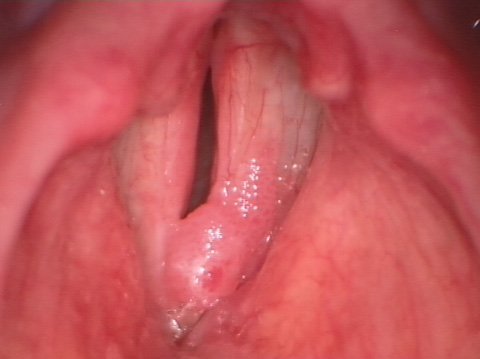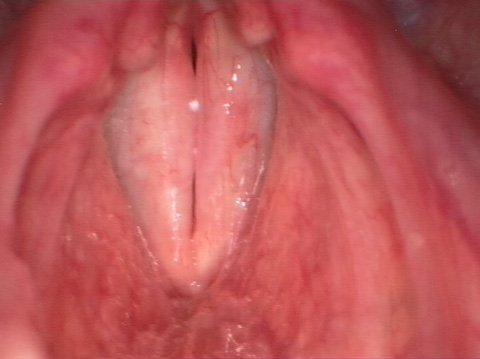When is voice surgery indicated for laryngeal papillomatosis, vocal papillomas or recurrent respiratory papillomatosis?
Indications for surgical management of laryngeal papillomatosis — vocal papillomas — recurrent respiratory papillomatosis:
- Hoarseness, rough voice
- Impairment of breathing
- After initial diagnosis, immunohistological tests for determining the virus subtype
When laryngeal papillomatosis, vocal papillomas or recurrent respiratory papillomatosis have been diagnosed for the first time, it next becomes necessary to histologically confirm the disease. Primarily, low-risk types must be distinguished from high-risk types. In this case, histological testing is required that also determines the virus subtype.
For this purpose, a surgical intervention should be performed that not only focuses on improving the voice, but likewise takes histological and immunohistochemical tests into account.
Moreover, any minor to major degree of hoarseness constitutes an indication for surgical intervention. Vocal papillomas should usually undergo early surgical management in order to minimize the risk of local spread to the non-affected portions of the vocal folds.
Surgery is almost always indicated for larger papillomas as well as when the proliferative spread takes the form of lesions with a lawn-like confluence.
Any limitation to the patient's breathing capabilities would pose a vitally urgent indication for surgery. In children, this disease is frequently accompanied by significant impairments to ventilation and a shortness of breath. In such cases, rapid operative management is imperative.
Laryngeal papillomatosis before surgery

Laryngeal papillomatosis after surgery

Voice recording: Vocal papilloma before surgery
Voice recording: Vocal papilloma after surgery

How is voice surgery for vocal fold papillomas performed?
Because laryngeal papillomatosis is a disease of the superficial vocal fold mucosa, the surgical procedure should take this condition into account. That entails delicate excision of all vocal fold papillomas with surgical precision while preserving the deeper-lying tissue layers.
The surgical method preferred by Dr. Wohlt is based on a microsurgical technique in which the visible portions of the papillomas are denatured by gentle coagulation and then removed. Afterwards, the underlying mucous membrane is reconstructed microsurgically. During this procedure, special attention must be paid to ensure that the deeper tissue layers are not impaired in order to prevent adhesions and scarring in this region.
Despite the gentlest of surgical techniques, there will be some patients in whom a disease recurrence cannot be counteracted. This is because laryngeal papillomatosis is a viral disease that cannot be healed completely by surgery.
Notwithstanding those facts, we have had patients in whom surgical intervention alone succeeded in making their disease disappear. In other patients, repeated interventions may be required; in some instances, patients have to be operated on hundreds to times. However, this only applies to very aggressive disease courses.
Laryngeal papillomatosis before surgery
Laryngeal papillomatosis after surgery

What happens during the postoperative phase after surgery for vocal papillomas?
- Voice rest (10-14 days)
- Abstinence from alcohol
- Abstinence from smoking
After surgery for vocal fold papillomas, the patient should maintain voice rest for a period of 10-14 days. During this time, the wound is allowed to heal, while the vibrating capability of the vocal folds can grow back.
Given the associated bleeding risk, drinking alcohol should definitely be refrained from during this wound healing phase. Likewise, the patient should stop smoking during this period.
Postoperatively, the patient has the option of getting vaccinated with a targeted tetravalent vaccine against the HPV virus types 6, 11, 16 and/or 18.
Since it is not sensible to vaccinate against one of the virus subtypes mentioned unless they have been isolated in the patient’s tissue, it is obvious that one must wait for the result of the immunohistochemical determination of subvirus type before administering the vaccination. If patients have a vaccinatable subtype, their vaccination is aimed at delaying any recurrence of the disease. In fact, we have observed in some of our patients that the disease-free intervals between postoperative vaccinations keep getting longer. In other words, vaccinated patients tend to need to undergo surgery less often.
The voice therapy program otherwise usually recommended after vocal cord surgery is not necessary in the aftercare phase of laryngeal papillomatosis. A phonotherapeutic intervention cannot prevent a recurrence because the disease is known to be caused by a viral infection.




